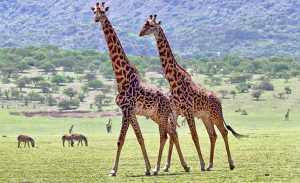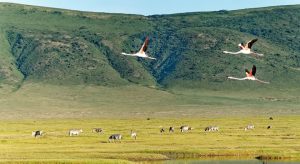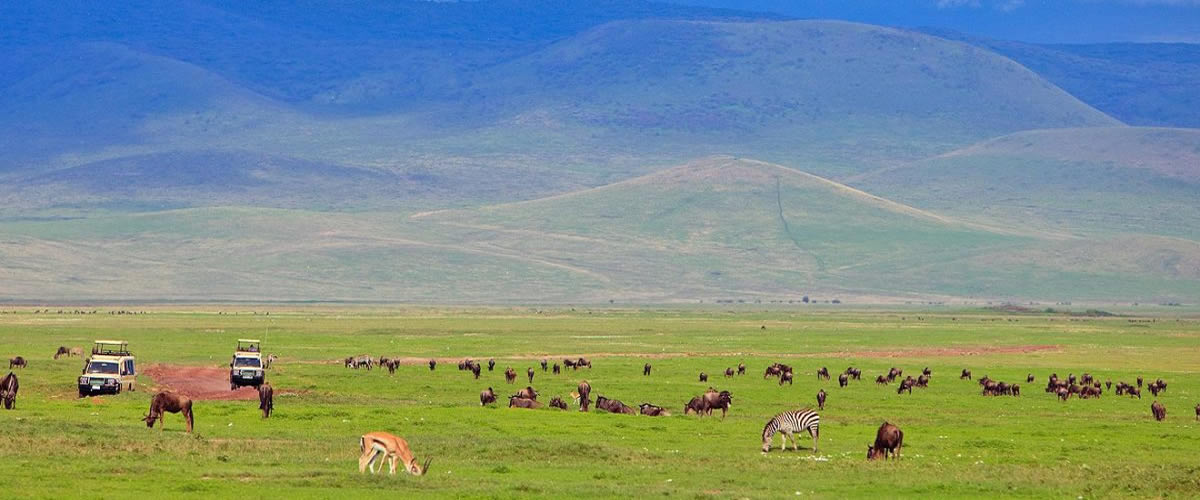The Ngorongoro Conservation Area is part of the Tanzania safari northern circuit and is blessed with the best blend of terrains, wildlife, archaeological sites as well as people in the whole of Africa. It’s sometimes referred to as the ‘African Eden’ and in addition is a revolutionary experiment in multiple land use. As for the Ngorongoro safari area, the aspect of multiple land use refers to allowing wildlife plus humans to co-exist in this natural environment. In collaboration with Tanzania government agencies, the local pastoralists have assisted in the preservation of the natural resources in the area to offer tourists a wonderful experience while in this area.

Giraffe Ngorongoro Crater
For first-time travelers to Ngorongoro Crater, the sights of this amazing crater will certainly sweep you off your feet! The Ngorongoro is a large caldera or a collapsed volcano, covering 250 square kilometers and 600 meters deep. This crater is a habitat for more than 20,000 animals among which are the remaining rare and endangered black rhinos. These rhinos come from the forests during the early morning mist, and their primitive figures offer a very remarkable impression, bordered by the very old crater walls. No fences or physical boundaries delimit the crater walls so animals freely enter and leave this crater, however, several of them prefer to remain within the crater due to the all-year-round availability of fresh pastures and water on the crater floor.
the bigger part of the crater floor is covered by open grassland, which turns yellow in the dry months of June with wildflowers. The Magadi Soda Lake in the Ngorongoro Crater is a major attraction for the beautiful flamingos in addition to other thousand species of water birds, whereas predators hide in the marshland from where they ambush their prey that comes to drink the water of the river which feeds into the lake. Furthermore, there are swamps on the crater floor, that provide water and shelter to elephants hippos, and several smaller creatures like frogs, lizards, and snakes. It is very rewarding to view game around the beautiful Lake Makadi as large antelope such as gazelles plus zebras come to have a drink here, whereas herds of hippopotami bask in the thick mud on the lakeshore.
Lerai Forest on the floor of the crater was named from a local Maasai word referring to ‘the elegant yellow-barked-acacia tree’. Several Elephants frequently graze in this forest as they take shade, especially during the midday, and they spend the early morning hours as well as the evenings in the open plains when there is less heat. This small forest is found on the floor of the crater and is a habitat for baboons, leopards, monkeys, and antelopes like the waterbucks plus bushbucks.
Humans plus their long-ago ancestors are part of the intriguing Ngorongoro landscape history dated millions of years ago. The most ancient signs of the existence of mankind in this Conservation Area are found at Laetoli. In this area, hominid footprints are well preserved in volcanic rock and are believed to be more than 3 million years old. The legend carries on to the Olduvai Gorge, which is a river gorge 100 meters deep cut into the volcanic earth of the vast Serengeti Plains. Buried in the earth’s layers are remnants of wild animals plus hominids that existed and died near a superficial lake in the middle of grassy plains plus woodlands. These remnants are dated to 2 million years back in time. Visitors get the opportunity to learn more about this charming story when they visit the site. The tour guides gladly offer a captivating on-site explanation of the gorge.

The Ngorongoro Crater – Tanzania
The most recent residents of the Ngorongoro Conservation Area are the Maasai people, who occupied the area about 200 years back in time. Their sturdy perseverance in traditional customs, as well as traditional costumes, has excited several visitors to this amazing area. Today, there are more than 41,000 Maasai pastoralists happily living in this conservation area with herds of cattle, sheep plus goats. the presence of these Maasai people is the major differentiation between this Ngorongoro Conservation Area and the national parks in Tanzania. Taking cultural tours, or village walks to the Maasai village offers the tourists an opportunity to interact with the local Maasai people, get an opportunity to learn more about their interesting culture, and also be part of the typical Maasai lifestyle.
Where to stay in Ngorongoro
- Ngorongoro Crater Lodge
- Ngorongoro Serena Safari Lodge
- Ngorongoro Sopa Lodge
- Plantation Lodge
- Gibb’s Farm
- Ngorongoro Farm House


